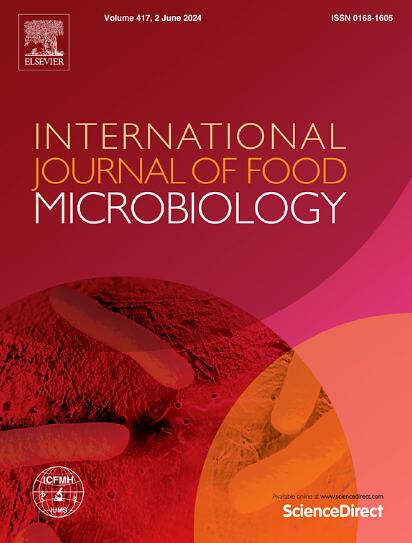通过元基因组学和风味学揭示副酸性乳酸杆菌 C5 对面包面团风味形成的影响
IF 5
1区 农林科学
Q1 FOOD SCIENCE & TECHNOLOGY
International journal of food microbiology
Pub Date : 2025-04-23
DOI:10.1016/j.ijfoodmicro.2025.111220
引用次数: 0
摘要
本研究通过宏基因组学和风味组学研究了副干酪乳杆菌C5对面包风味化合物产生的影响。宏基因组分析显示,副干酪乳杆菌C5促进了面团中碳水化合物、氨基酸和脂质代谢。特定微生物种类与风味化合物之间的相关分析表明,副干酪乳杆菌与面包中的关键风味化合物如2-壬烯醛、(E)-、2-辛烯醛、(E)-、苯乙醛和己酸乙酯呈正相关。建立了副干酪乳杆菌C5酵母面包风味化合物代谢途径的预测网络,阐明了相关基因和酶的微生物注释。这些发现强调了副casei和酿酒酵母在提高碳水化合物降解、乙酰辅酶a合成、琥珀酸转化、酰基辅酶a生成、转氨酶、醇脱氢酶和羧酸酯酶的编码酶活性方面的协同作用。这些结果为副干酪乳杆菌C5增强面包风味的机制提供了新的见解。本文章由计算机程序翻译,如有差异,请以英文原文为准。
Revealing the influence of Lacticaseibacillus paracasei C5 on the flavor formation of bread dough by metagenomics and flavouromics
This study investigated the impact of L. paracasei C5 on the generation of flavor compounds in bread through metagenomics and flavouromics. Metagenomic profiling revealed that L. paracasei C5 facilitated carbohydrate, amino acid, and lipid metabolism in the dough. Correlative analyses between specific microbial species and flavor compounds demonstrated a positive association between L. paracasei and key flavor compounds in bread, such as 2-nonenal,(E)-, 2-octenal,(E)-, benzeneacetaldehyde, and hexanoic acid, ethyl ester. A predictive network outlining the metabolic pathways responsible for L. paracasei C5 sourdough bread flavor compounds was established, elucidating the microbial annotation of pertinent genes and enzymes. The findings underscored the synergistic role of L. paracasei and S. cerevisiae in enhancing the activity of encoded enzymes involved in carbohydrate degradation, acetyl-CoA synthesis, succinate conversion, acyl-CoA production, transaminases, alcohol dehydrogenase, and carboxylesterases. These results offer novel insights into the mechanisms by which L. paracasei C5 augments bread flavor.
求助全文
通过发布文献求助,成功后即可免费获取论文全文。
去求助
来源期刊
CiteScore
10.40
自引率
5.60%
发文量
322
审稿时长
65 days
期刊介绍:
The International Journal of Food Microbiology publishes papers dealing with all aspects of food microbiology. Articles must present information that is novel, has high impact and interest, and is of high scientific quality. They should provide scientific or technological advancement in the specific field of interest of the journal and enhance its strong international reputation. Preliminary or confirmatory results as well as contributions not strictly related to food microbiology will not be considered for publication.

 求助内容:
求助内容: 应助结果提醒方式:
应助结果提醒方式:


